Introduction
The Kenwood TS-930, while many years out of production and lacking many of the technology developments of the past twenty years, continues to be an excellent HF radio with a unique ability to hear multiple signals in a pileup. This particular performance advantage has, for whatever reason, eluded the designers of more modern radios. As a partner in the new HC8 contest station on Isla San Cristobal, I undertook to obtain and refurbish a number of 930s, but we were disappointed by the lack of reliability we experienced.
The problems we observed included
- Several radios experienced outright power supply failure, and one had a difficult-to-trace low frequency oscillation in the 28V circuit that involved the output amplifier, and destroyed amplifier driver bias transistors (this was cured by replacing the 2N5885 regulator transistors).
- One radio experienced intermittent loss of receiver sensitivity, and another experienced loss of microphone input on SSB.
- AGC overshoot made reception difficult of signals in the range of S9+20 dB.
I aligned each radio and ran it for a four-day period at high transmitting duty cycle on CW and SSB, using computer logging software to transmit into a dummy load (which itself required a cooling fan). At the end of the burn-in period I checked for unchanged sensitivity, power output and fan operation. Despite this we experienced failures in contests, with the requirement to return the radios to the US for repair.
I was aware of the change of TS-930 design at S/N 310XXXX that responded to the many early problems (digital board through holes, amplifier through holes, receiver muting, sidetone, etc.) that are well documented in listings of modifications, as well as in Kenwood's application notes. Our radios have serial numbers ranging from 4M to 8M. All have been standardized to the same configuration, so we would be able to separate the sources of any problems. All our radios have the stock CW and SSB IF filters (TS-930 SSB filters are wider than the pin-compatible ones for TS-940/850) and the PIEXX digital board, both for reliability, new functions such as main tuning knob control of RIT when dial is locked, and to be able to use computer logging and control.
It should be noted that the power situation at the end of a long rural line is not favorable, nor is the fact that our radios experience the rough handling as airline baggage (even in the excellent foam-lined Pelican cases) and then sit idle for extended periods in the foggy and humid equatorial mountain-top air. In order to minimize our exposure to line voltage variations and surges, we configured all the radios for 240V operation and used professional-grade surge protection. The short line cords are a unique color and are firmly attached to the radios so other equipment in the shack cannot inadvertently be connected to 240V through the standard EIA connector. We have the option to switch to 220V if the line voltage sags, although that has not been necessary.
With the modifications outlined in this note, our TS-930s now exhibit excellent reliability, and have worked well for the entire preparation and contest time in both modes of the recent CQWW contest. I thought there might be some interest in what I found was required to make them bulletproof.
Replacing TS-930 Resistors and Shunt Zeners with Series Regulators
The TS-930 power supply for serial numbers higher than 310xxxx generates two voltages, 28.5V for the power amplifier and antenna tuner, and 21.7V for the digital board and the signal board. The 28.5V is regulated by the two TO3 pass transistors on the heat sink, and the 21.7V is generated by separate transformer secondary taps and diodes that generate 31.9V which is reduced to 21.7V by the TO220 transistor on the power supply heat sink.
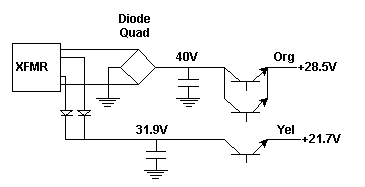
The power switch has a pole that opens the +28.5V to most of the radio, including the circuit that runs the 21.7V regulator. This is apparently so the radio will just turn off without the time delay and rude noises of the filter capacitors discharging.
The power supply uses high-wattage resistors and zener diodes in the power supply fan case to reduce the 21.7V secondary supply voltage 7.5V and 15V for the digital board (which has 5V and 12V regulators) and for the signal unit, which has an 18V regulator. The 21.7V is distributed by the yellow wires via a black terminal block between the antenna tuner and the filter unit; this block also has the switched +28.5V orange wires. The original circuit looks like this:
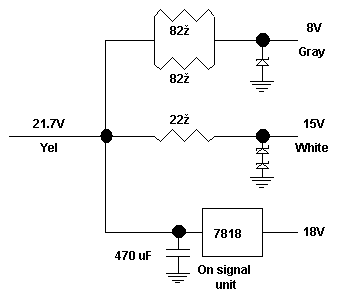
The main schematic diagram of the radio is wrong, it shows the 33? resistor that is the third supply voltage for the digital board connected to the 21.7V instead of the 28.5V line.
The dissipation in the resistors and diodes is above their ratings, and this could be a reliability problem. This new circuit replaces the resistors and diodes with 78xx 1 A. TO220 regulators mounted on the power supply heat sink. In addition to having less dissipation, the regulators are short-circuit proof. There are holes in the heat sink, and the TO220 tabs can be bolted with 4-40 small-pattern nuts and bolts. I use a locking compound on the bolts so they won't vibrate loose later.
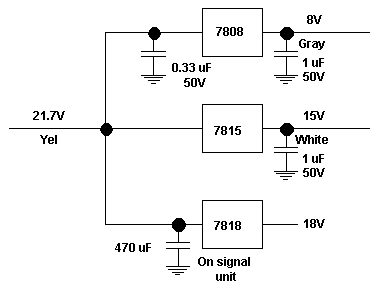
The regulators need capacitors near them, especially if they are driving the PIEXX board, which has switching regulators with inductors at the input. The regulators should be prewired, and the wires are connected to the voltage points inside the power supply fan case.
To make the change, proceed as follows (the same steps are necessary to replace the pass transistor with an NTE377, if the original is burned out).
- Unplug the radio and remove the top cover.
- Remove the four black screws holding the fan case onto the heat sink, and unplug the fan wire from the power supply board so it won't break at the fan connection. Free the tab from the case bottom, and tip the case down and put something under it to hold it horizontally to work on.
- Remove the remaining two black screws holding the power supply heat sink to the radio. You will find the heat sink will not tip out without additional work.
- Unscrew the screw holding the diode bridge to the heat sink. This screw will be retained by the heavy wires from the transformer, so you don't need to pry it out completely, just free the diode quad from the heat sink so the heat sink can move.
- Remove the two lugs and heavy red wire from the TO3 pass transistors by unscrewing the two middle screws while holding the nuts with long-nose pliers on the inside. Leave the screws in place in the transistors to hold the insulating washers.
- Now you can tip the heat sink forward far enough to be able to reach the screw that holds the pass transistor. This transistor has had loose screws in some radios, so tighten it up while you can. If you unplug the pass transistor, be sure to note which way the plug goes on (some have plugs, some have the blue, green and violet leads soldered on and covered with heat shrink tube).
- Locate the field of small holes near the upper edge of the heat sink, near the outside edge of the radio. As viewed from inside the radio, the two regulators mount to the holes in the bottom row (the top row is also OK, and easier to reach if you are not removing the heat sink). Before you do anything else, route the wires from the regulators beneath the heat sink so they can be connected to the terminal strips in the fan case.
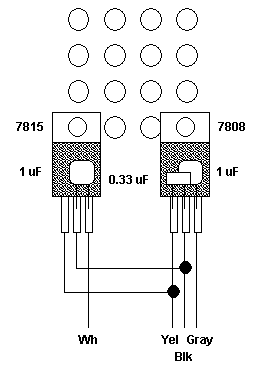
- The 4-40 small pattern nut just fits between the heat sink fins. Use a thin tool that can hold the nut on the end, and orient the flats of the nut to go between the fins. It's helpful if the parts are magnetic, so you can recover a dropped nut (be sure to cover the holes in the chassis with tissue or a rag). Use a 4-40x3/8" screw to fasten the regulators to the heat sink. The same nuts and screws are used in DB9 and DB25 connector shells. I use some heat sink compound on the back of the regulators. No insulation is required. Check again to be sure the screw for the TO220 pass transistor is tight and the transistor is oriented up so you can get to the terminals.
- Reconnect the lugs to the backs of the TO3 pass transistors, holding the nuts with log-nose pliers and using a drop of retaining glue or Loctite. Reattach the diode quad to the heat sink.
- Attach the heat sink to the radio with the middle black screws. Check that there are no wires being pinched between the heat sink and the chassis. Now you can hook up the regulator wires to the terminal strips in the fan case.
- The resistors to be replaced are inside the power supply fan case. You will notice that the resistors will have lost their color coding from overheating, and the terminal strips may be somewhat charred, from overheating. Cut out the two 82? resistors and their zener diode, and cut out the 22? resistor and its two zener diodes. You can save these in case of trouble, but the new circuit should be more reliable.
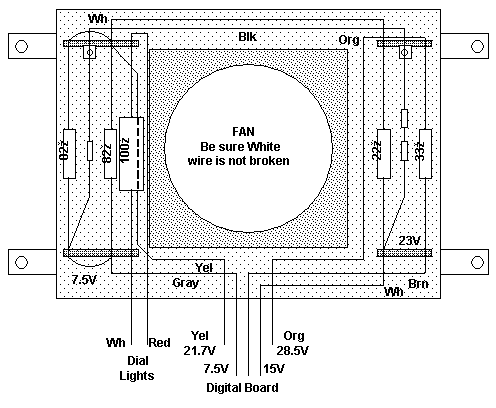
The fan case should now look like this:
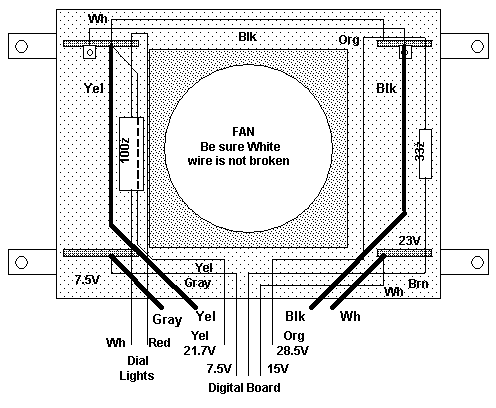
Cut to length and solder the Yellow, Black, Gray and White wires to the terminal strips, making sure they are connected to the same color wire that is already there. Dress the wires in place to avoid the fan with a tiny nonmetallic cable tie or twister.
- Plug in the radio, being careful of high voltages at the power switch and transformer. Connect a digital voltmeter to radio chassis ground and check the voltages at the terminals in the fan case. Turn the radio power on momentarily to check each of the voltages:
Orange +28.5
Yellow +21.7
White +15
Gray +8
- Unplug the radio. If you wish, you can replace the 100ohm resistor with a 5W unit, and the 33ohm resistor with a 3W unit. Using a piece of wire or an oiler, place a drop of oil on the fan shaft. Check to be sure the fan wires aren't broken, and reattach the fan case with the four black screws. Plug the fan back into the power supply board. Replace the top cover and test the radio.
Replacing the 21.7V Pass Transistor
Despite the attention in the literature to the 28.5V TO3 regulators that supply the power amplifier, almost all of our power supply failures have been traced to the 21.7V regulator circuit. As the pass transistor is failing the radio will typically exhibit unusual operation, such as chirpy signal or intermittent display.
The 21.7V regulator is a pair of cascaded emitter followers driven by a 22.5V zener diode fed from the 28.5V supply switched through the power switch. The zener diode D10 and the first transistor Q6 are on the power supply board, and the second transistor Q3 is the TO220 transistor on the heat sink. The schematic incorrectly shows C13 to be 25 uF 100V (it is 100 uF 25V).
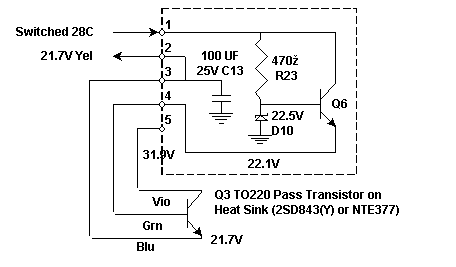
Use an insulated clip probe. If the output of the 21.7V supply measures OK on the yellow wire at the terminal strips in the power supply fan case or the black terminal strip in the narrow space between the output low-pass filter and the antenna tuner, then all is OK.
If the voltage is not correct, it will typically be either 31.9V or near 0V (say, 0.5V). This means the pass transistor Q3 is either shorted or open.
- Unplug the radio and remove the top cover.
- Plug in the radio and power on, measure the voltage on the orange wire, either at the top of the power supply board or at the 33ohm resistor in the power supply fan case. It should read 28.5V. If it is OK, the 28V regulator on the board and the pass transistors are OK.
- Measure the voltage on the yellow wire, either at the power supply fan case terminal strips (you can reach them with an insulated probe in the slot above the heat sink) or at the black terminal strip in the space between the output low-pass filter and the antenna tuner. If it is approximately 21.7V, Q3 and Q6/D10 are OK and the problem, if any, is not in this part of the power supply.
- If it is not 21.7V, it will typically be either approximately zero volts (0.5V or so) or 31.9V. This means Q3 either has an open or it has a collector-emitter short . Usually, but not always, if Q3 is zapped it will take Q6 and D10 with it. If the voltage isn't right, you need to determine if the problem is Q3 or Q6 or both. With the radio unplugged, unplug the 5-pin connector on the power supply board and use a digital voltmeter with a diode scale to check the Q3 B-C and B-E diodes; also check for a C-E short. Poke a short length of solder into the connector, and use clip-type meter leads. The readings will typically be (assuming the open circuit meter reads 1.4V)
Pins on Red lead Black lead
5-pin conn. on Base on Base
Grn-Blu 2-3 0.7 1.4
Grn-Vio 2-5 0.7 1.4
Blu-Vio 3-5 1.4 1.4
- If the readings are OK, it is likely that the problem is on the power supply board. If any of these readings is not as expected, Q3 is dead and will have to be replaced (a remote possibility in the case of an open circuited diode is a bad connection at Q3, so check the connector by wiggling it). If Q3 has blown, it may also have taken Q6 and D10 with it. It is worth disconnecting Q3 before removing anything and checking Q6 and D10 to determine if you also need to take out the power supply board. Either unplug the connector at Q3 or cut the three thin wires right at Q3. Be careful not to short anything when measuring voltages, as you will hate yourself if you zap a working circuit while measuring voltages. Reattach the 5-pin connector to the power supply board, plug in the radio and turn it on momentarily to check the voltages on the three wires:
Vio 31.9
Grn 22.3
Blu 0 (with Q3 disconnected, 21.7 in working regulator with Q3 connected)
- If these voltages are OK, the PS board is OK; unplug the radio and review the data
| 21.7V OK |
Q3 OK |
This part of PS is working; check resistors in PS fan case, look for pinched white or gray wires, check 7818 18V regulator on Signal Unit |
| 21.7V bad |
Q3 OK |
Probably means Q6/D10 bad; remove power supply board and replace |
| 21.7V bad, 22.3V (Q6) OK |
Q3 open or short |
Replace Q3; Q6/D10 OK |
| 21.7V bad, 22.3V (Q6) bad |
Q3 open or short |
Replace Q3 and Q6/D10 |
Replacing Q3
- To replace Q3, you need to remove the power supply heat sink as in steps 1-6 above. Remove the four black screws holding the fan case onto the heat sink, and unplug the fan wire from the power supply board so it won't break at the fan connection. Free the tab from the case bottom, and tip the case down and put something under it to hold it horizontally to work on. Remove the remaining two black screws holding the power supply heat sink to the radio. You will find the heat sink will not tip out without additional work. Proceed to free the diode quad and the lugs on the TO3 transistors so you can get at the screw that holds Q3.
- Now you can tip the heat sink forward far enough to be able to reach the screw that holds the pass transistor. If you unplug the pass transistor, be sure to note which way the plug goes on (some have plugs, some have the blue, green and violet leads soldered on and covered with heat shrink tubing, my preference). Remove the pass transistor and replace it with a new one. If the transistor has a gray silicone insulator under it, use it again with the plastic washer to insulate the screw; if it has a mica insulator, use a new one and smear a bit of heat sink compound on both sides before placing it. If there is a connector, plug it onto the transistor now; if you need to solder the wires on, cut the pins on the transistor shorter and use heat shrink tubing on the wires. In some radios, I've found this screw was not tight so be sure it is snug when you are finished so the transistor won't overheat and fail.
If you are going to replace the resistors with regulators, now is the time to do it while the heat sink is accessible. Also, if Q6/D10 are to be replaced, it's easier to do with the heat sink out of the way.
- Reconnect the lugs to the backs of the TO3 pass transistors, holding the nuts with long-nose pliers and using a drop of retaining glue or Loctite. Reattach the diode quad to the heat sink.
- Attach the heat sink to the radio with the middle black screws. Check that there are no wires being pinched between the heat sink and the chassis. Clean, oil and replace the fan.
Replacing Q6 and D10
- You can check Q6 for a collector-emitter short by measuring from pins 1-4 of the 5-pin connector (should show an open with both polarities), but you can't measure all the junctions. If you need to replace Q6 or D10, you will need to remove the power supply board. Make a sketch of where all the connectors and wires go. If both Q3 and Q6 are blown and you have the heat sink open, do the power supply board repair before reinstalling the heat sink. The power supply board can be removed without removing the heat sink, but it is more convenient to do it before you reinstall the heat sink if you have replaced Q3.
Unplug the inline bayonet connector in the red wire to the power amplifier. Unsolder the heavy yellow and white wires from terminal 28A. Unsolder the orange wires from 28B. Unsolder the black ground wires from the ground terminal. These terminals are at the top of the power supply board. Wear safety glasses so you don't flick solder in your eye, and use a solder suction pump to remove excess solder. Typically, the lugs will come unsoldered from the circuit board, but it is easy to put them back straight after the wires are unsoldered.
- Unplug all the connectors, noting which goes where. Now remove the two screws that hold the bracket to the chassis, using a magnet (a necessary tool for any of these jobs) to reclaim them so they don't roll down a hole into the space under the signal board (it's a big job to remove and replace it). Lift out the power supply board.
- Remove the power supply board from the bracket by removing the four screws at the corners. Now you can locate Q6 and D10. Once you have gone this far, you might as well replace both, since it takes a separate setup to measure the zener, and the transistor is easy enough to change out. Use a solder suction pump and observe the polarity of the zener and the connections of the proper leads. After the old transistor is removed, you can check the junctions using the digital multimeter. I'd add a 47 ohm current-limiting resistor in series with the collector of Q6.
- Replace the power supply board by reattaching it to the bracket, then reattaching the bracket to the chassis. Be careful not to pinch under the bracket any of the wires coming from the fan case or the back of the chassis. Plug in all the connectors. Resolder the black wires to the ground terminal, the orange wires to the 28B lug and the yellow and white wires to the 28A lug. Make sure the lugs are well-soldered to the circuit traces. Plug in the red wire to the power amplifier.
- Before you power up, check with an ohm-meter from the orange (28.5V) and yellow wires (21.7V) to be sure there are no shorts. You should see capacitors charging up in either case. If there is a short, check carefully for a pinched wire under the power supply board. If this measurement shows no shorts, plug in the radio and power on, measuring the voltages on the orange and yellow wires (you can reach the yellow wire terminal in the fan case with a well-insulated probe). The voltages should be
Orange 28.5
Yellow 21.7
If OK, you are done and can replace the heat sink, fan cover and case top. The 21.7 voltage has no effect on any critical adjustments, so no realignment is required.
Fan Operation Check or Repair
Check the operation of the 12V Power Supply fan and the 12V Power Amplifier fan by running into antenna or dummy load at 50W as follows:
Mode: TUNE
Send/Rec: SEND
Car: Midscale on meter
Power: 50W
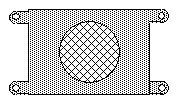
After a few moments both fans should start up. In any event, proceed to refurbish as follows:
- Unplug radio
- Remove 4 black screws holding metal tabs top and bottom of fan box.
- Tip PS fan assembly back, rotating around wires at bottom (pull some slack in the black fan wire from radio so the weight of the fan motor won't break the connection to the fan))
- Fan blades should spin freely when turned by hand, with the lumpy feeling of a DC motor
- Check for mechanical interference with fan blades, for example by fan screen; correct if found
- Fan white wire should read about 60? to ground, and black wire should connect to ground; if motor reads open the fan is doomed and will need to be replaced
- Remove 4 silver screws on outside of fan box to remove fan motor assembly
- While fan is out, remove screen and reshape it to bow out enough to ensure clearance
- Place a drop of WD-40 or light oil on the bronze bearing where the shaft goes through, spin shaft
- Check for mechanical interference; on later serial number radios there is a small flat spring wiping the motor shaft under the fan hub to quiet the motor, don't damage it
- Being careful not to crush any wires, replace the four silver screws to fasten fan to box; make sure no wires rub the fan blades; look in holes and rotate the screen to get openings for the four screws
- Test fan by plugging in radio, run 50W transmit test with antenna or dummy load; fan should start and run quietly if motor measured good. Voltage on fan should be 10 to 12 VDC when PS is hot
- Some have suggested wiring the fan to run continuously through a diode from the +8V available in the fan case, but this has not proven necessary with the power supply modification to remove the shunt regulators, as the heat sink runs noticeably cooler after the mod
Once PS fan is working, clean and oil the Power Amp fan, which comes straight out after four mounting screws and washers are removed.
If a either fan is beyond repair, substitute a replacement or an 80x25mm 12V computer muffin fan. New holes are needed for the mounting screws, which are 2.81" on centers (the existing holes are 2.45" on centers). Wire the red fan wire to the white supply wire, and the black fan wire to the black supply wire.
Lubricating the Top Cover Door
The sliding door in the top cover becomes very difficult to move after some years of service. Any time you have removed the top cover, lubricate the sliding door in the top with Silicone liquid or grease lubricant on the plastic slides. Press down one edge, hold in place with screwdriver, wet the corner of piece of paper with Silicone spray, run it between the door and the lid, do same all around and also between black plastic and door. This is much easier to do while the cover is off. Be careful of the line voltage on the POWER switch on the front panel, and don't short anything around the power supply voltage regulator. Do not use a petroleum-based lubricant such as WD-40 on plastic parts, as they will swell and deteriorate.
Line Voltage Change to 240V
Because of low line voltage and neutral wire problems, our 120V line voltage ranged from 106 to 113V, causing hum when the regulators dropped out of regulation. Attempts to rewire the transformer for 100V operation with low line voltage (below 110V with load) resulted in overheating of the power supply, since with such a large change (20%) the unregulated voltages rise above the design limits.
If the 120V line voltage is low, use the 240 or 220 volt switch position.
- Replace the 6A fuse with a 4A fuse; retain the 6A fuse if it is desired to change back later
- Turn the switch on the bottom of the radio to 240V, or 220V if the voltage is low
- Plug in special yellow 240V line cord, attach to rear panel so it won't be used on a 120V radio
- Plug into a 240V outlet or extension cord (surge absorber preferred, make sure ground is OK)
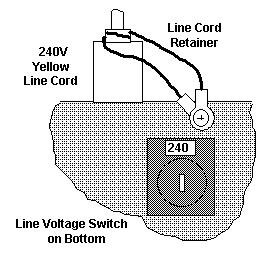
Cleaning Signal Unit Connectors with Contact Cleaner
On several occasions receivers have suddenly lost sensitivity for extended periods, and other radios have had sudden complete interruptions of microphone input. While there can be other causes for these intermittent failures, they were in each case traced to the connectors at the Signal Unit. In all cases the intermittent behavior was eliminated by cleaning the contacts of the connectors in the particular signal path.
The idea developed that this reliability issue was due to corrosion of the connectors on the Signal Unit. It was decided to clean all of the connectors to avoid any recurrence of the intermittent problems, a course which has been successful. In some cases it was possible to observe discoloration of the connectors that was possibly indicative of corrosion.
I remove each and every connector, one by one, and spray or dab the pins with contact cleaner, then rub the connector in and out a couple of times. I do all the connectors, including the filter connectors and especially the microphone and coaxial RF connectors. This has solved several complaints of intermittent or deaf radio or no transmit audio on SSB. The intermittent problems went away.
After I did this, I learned from several other TS-930 users that they had experienced the same problems, and had resolved them in essentially the same way.
AGC Modification with Germanium Diode
An AGC modification results in a big improvement in the ability to copy signals in the S9 to S9+20 range. This modification prevents the AGC overshoot that blanks the first character of a loud CW signal, with no bad side effects. A germanium is diode placed across D125 under the CW 455 kHz filter, with the "bar" end toward the rear of the radio (opposite to the bar on D125). The new diode is soldered across D125, which is located under the large 455 kHz 500 Hz IF filter.
- Unplug radio
- Turn radio upside down and remove bottom cover (8 screws, including the ones that hold the top cover at the sides).
- Locate the 500 Hz 455 kHz crystal filter (the largest one, on your right as you face the bottom of the radio from the panel end), lift out harness, remove screw at each end and lift it out.
- Underneath you will see R375 and D125; solder the Germanium diode across D125 as shown.

- Replace IF filter, being careful not to damage connectors; push the connectors down tight before you replace the screws. Put a label "R375+1N270" on the filter to show the AGC mod.
- Test the radio before you replace the bottom cover; watch out for line voltage at the back and behind the POWER switch on the panel.
- Before you replace the bottom cover, you should also clean the connectors on the Signal Unit.
Alignment with Non-contacting Pickup for Oscillator Frequencies
In some cases it is desired to check or adjust the transceiver alignment while not having access to formal test instruments, and without opening the radio and exposing the circuits to possible damage through connecting test leads. Use an insulated wire as a pickup antenna by pushing an insulated loop through the appropriate tuning hole in the bottom (or side cover in the case of the 20 MHz master reference oscillator). A second radio can be used to measure the frequency to the accuracy required.
The first step should be to check the accuracy of the reference oscillator. I connected a small outdoor antenna wire to an insulated loop pushed into the side cover opening for the oscillator adjustment, with the other end of the loop connected to the antenna connector on the radio. With this setup, monitor the 20 MHz signal of WWV and adjust the insertion of the loop for somewhat equal signals from the external standard and the signal from the internal oscillator. You will be able to hear the beat note and adjust the oscillator for zero offset from the standard frequency. Let the radio warm up for 30 minutes or so to be sure everything has stabilized.
As another example, consider the alignment of the Carrier-2 oscillator used to provide variable bandwidth. The variable bandwidth tuning (VBT) uses two IF filters, one at 8830 kHz and the other at 455 kHz. The conversion oscillator at 8375 kHz determines the degree of overlap of the filter passbands. If the VBT knobs are set to widest position, the conversion oscillator should be at exactly 8375.0 kHz.
The can be done by connecting a counter (for example, an antenna impedance bridge counter) through a DC-isolated probe to C298 of the signal board, but if there's no other work to be done leave the case closed and use an insulated wire loop poked into the hole as an antenna to hear the oscillator on a second radio.
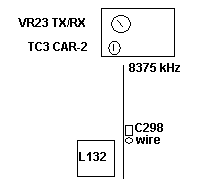 
The radio should be set up (see Service Manual, pg. 67, adjustment and test points are on pg. 77)
Mode: USB
Transmit: REC
VBT: CW, High Cut fully CW, Low Cut fully CCW (no narrowing)
- Measure the frequency at 8375 kHz
- Adjust VR23 so there is no change in frequency from transmit to receive
- Adjust TC3, the small trimmer capacitor, so the frequency is exactly 8375.0 kHz
At this time you should also check the carrier oscillator at 8830 kHz
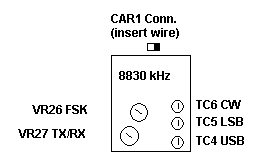
The radio should be set up (see Service Manual, pg. 66, adjustment and test points are on pg. 77)
Mode: USB
Transmit: REC
VBT: CW, High fully CW, Low fully CCW
- Measure the oscillator frequency, which should be 8831.5 kHz.
- Adjust VR27 so there is no change in frequency from transmit to receive
- Set TC4 so the frequency is 8831.5 (I prefer 8831.6, you can go by the sound of the receiver audio to get the upper and lower signal levels equal, at +300 and +2.9 kHz.
Now switch to LSB, and set TC5 for 8828.5 kHz. Switch back and forth between USB and LSB, and trim the LSB oscillator until the noise sounds the same. Then switch to CW and NARROW, set TC6 for 8830.0 kHz. Last, connect a dummy load or antenna and switch to FSK transmit and set VR26 for 8827.79 kHz.
Last, check the setting of the CW Pitch and the Notch. Turn on the Marker oscillator, put the rig in CW mode, and check to see that the pitch covers the desired range. I set the CW Pitch so it is zero beat with the knob at 12 O'clock, so you can tune either sideband. The CW Pitch is set by L173 at the far right rear of the Signal Unit (bottom of rig). While you have a received tone, check the Notch by pushing in the NOTCH button and tuning the control for a null. With the offset tone at 1.5 kHz, the null should be at 12 O'clock. If it's not close, adjust L167 on the Signal Unit.
Don't forget to set Moni, Sidetone and other adjustments (AGC Delay, for example) before the radio is stuck under a shelf or cabled in place.
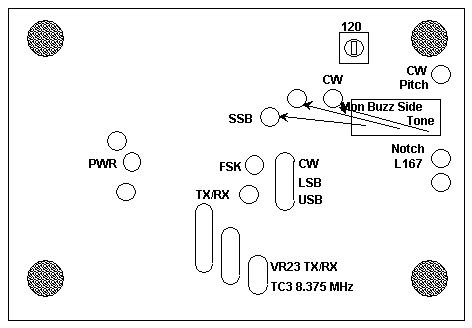
A Note on Alignment Levels
Clif Holland of Avvid, a respected repairer of Kenwood radios, emailed me to note that the Japanese specification for the standard signal generator used in alignment is different from the US signal generator calibration. The 930 service manual refers to signal levels in dBuV, so I had assumed 0dBuV was 1 uV and 40dBuV was 100uV.
But not so. Clif is right and I'm off by 6 dB. I checked it out, and although I see no mention of the issue in the TS-930 or TS-950 manuals, I found a table in the TS-850 service manual, pg. 96, that confirms this. It has two columns:
Japanese "SG" American "SG"
-6dB 0.25uV
0dB 0.5uV
6dB 1uV... etc.
40dB 50uV... etc.
Apparently the JA generator defines output in terms of open circuit voltage rather than voltage into a matched load. This 6 dB difference affects the alignment of the RF PIN attenuator start point as well as the S-meter settings for S1 and S9. Since the manual specs are ±4 dB anyway the difference will be mighty small except for a more active S-meter.
CW Reception on USB
To listen on USB on a 930 in CW mode, adjust the "CW Pitch" (BFO) coil L-173 (yellow core, farthest right-rear on bottom, there's a hole) so you have zero-beat at center position (12 o'clock) on the CW PITCH control on the front panel. If measuring frequency of this oscillator, this yields 100.0 kHz rather than 99.2 kHz.
Now if you turn the pitch control clockwise from center you get LSB as before, but if you turn the pitch control CCW from center you get USB. No retuning of filters or carrier oscillators is required. This mod has no effect on SSB.
I use this on our TS-930s at HC8. The only problems are that it makes the TUNE mode zero-beat if the pitch knob is centered, and also if an op isn't familiar with the setup on CW it can be concluded that the receiver is not working if the pitch knob is centered.
Operating Notes
I found it's difficult to tighten the nut on the Antenna UHF connector. Lacking a special spanner, you can carefully tap the Antenna connector nut with screwdriver and small hammer, as with the nuts in electric boxes. Don't overdo it.
For use with an external receiving antenna, one needs the hard-to-find 262 degree 8-pin "horseshoe" DIN-8 connector used to bring a separate receiving antenna in and out of the transverter socket (available from Kenwood and Yaesu, and HRO, but seldom found when needed). In an emergency we found that a standard DIN-5 connector will plug in and provide access to the receiver input and ground, while the small slide switch makes the transmit antenna output available at the adjacent RCA phono connector to connect to an receive-antenna selector switch (inadvertent mis-setting of this switch is a source of occasional complaints of deaf receiver).

It's good practice to have a relay that disconnects the receiver input from any antenna and shorts it to ground during transmit, so the transmit power isn't returned to the receiver from a separate receiving antenna. When used as a second receiver in a multi-op setup, this relay can also be run by the AMP relay line of the transmitter on the same band.
We don't use the noisy and slow amplifier relay (28V to NC pin), but make a transistor switch adapter in the DIN-7 plug for the PTT input and AMP output. This is faster, less noisy and more reliable. With the AL-1200s we use the speedup circuit found on K6XX's web site.
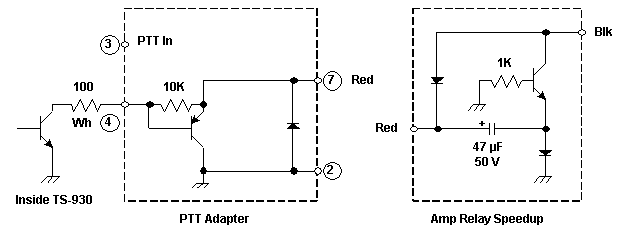

Naturally, we've had to cure hum and RF problems when using two radios and a microphone switch box along with a voice recorder, but this has been resolved by using double shielded twisted pair but not connecting the shields at both ends except through RF bypass capacitors. I have a circuit, based on K8CC's in the NA manual, that works very well for me. There are some curious audio/brain effects I've read about in a Bell Labs book on hearing and sound that are interesting to experiment with, including wiring headphones for out-of-phase reception.
One remaining problem is RF leakage of the display waveforms on the band-select cable from the PIEXX board. It appears this should be shielded. With the removal of the resistors in the PS fan case there is now room for some real back-panel connectors, DB9(F) for the RS-232 connection and DB25(F) for the band data. I cut off the unneeded wires in the RJ45 connector to avoid any problem with the PIEXX board.
Replacement Semiconductors
Although there are many sources of the original transistors, it has proven convenient and reliable to use the current replacement semiconductors offered in the US by NTE. Here is a list of suitable replacements:
2SD843(Y) NTE377
2SC2235(O) NTE382
XZ-225 NTE5080A
2N5885 NTE181
MRF485 (2) NTE236 (2)
2SC496(Y) NTE295
2SB861(C) NTE398
2SC1815(Y) NTE85
I've looked in vain for a TO220 power transistor that does not require the insulated mounting, but have not found one that has low enough thermal impedance and high enough current and power ratings. I've seen a suggestion to replace the 22V emitter follower with a 7824, but this might sacrifice the control by the switched 28.5V. I select from the NTE5058A (nominally 22V) individual zeners that provide 22.5 volts; the lead length of mounting to the circuit board affects the voltage, which rises with the operating temperature of the diode. If I measure them in free air with clip leads, I get a higher voltage reading because they get a lot hotter after a moment's operation.
I was surprised to be able to make a successful replacement of the expensive but burned out MRF485 RF driver transistors (don't ask!) with the relatively inexpensive NTE236. I made no effort to match the NTE replacements, and the amplifier seems to work fine; I reset the bias adjustment per the instructions in the service manual.
I was concerned about the thermal impedance of the replacement TO3 transistors NTE181, which also have relatively low current gain, but a matched pair (NTE offers these designated as NTE181MP) was used with success to replace a pair of defunct 2N5885 28.5V regulators.
Kenwood Service Bulletin Reference
TS-930S ASB-0863 INCORRECT LINE VOLTAGE SETTING
TS-930S ASB-0866 CW HETERODYNE TONE WITH VBT CONTROL
TS-930S ASB-0867 SSB TX AUDIO TONE QUALITY SN < 3080001
TS-930S ASB-0868 LOSS OF RX SENSITIVITY
TS-930S ASB-0869 PLL UNLOCK / BLANK DISPLAY
TS-930S ASB-0872 CW PITCH TONE SHIFT WHEN MONI SWITCH IS ON
TS-930S ASB-0873 CW VBT - SIMPLIFIED ALIGNMENT
TS-930S ASB-0874 RF FEEDBACK WHEN USING EXTERNAL SPEAKER
TS-930S ASB-0875 RX AUDIO OSCILLATION
TS-930S ASB-0876 RF FEEDBACK INTO MIC CIRCUIT
TS-930S ASB-0879 ALC LEVEL DRIFT AT 28 MHZ
TS-930S ASB-0881 POWER SUPPLY SURGE PROTECTION
TS-930S ASB-0884 15 MTR INTERNAL BEAT NOTE
TS-930S ASB-0886 INTERMITTENT TX POWER OUTPUT
TS-930S ASB-0893 NOISY POWER SUPPLY FAN
|


















